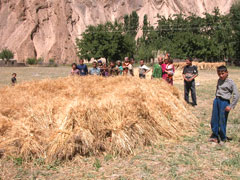
Scientists identify wheat germplasm suitable for acid soils

NSW Department of Primary Industries (DPI) scientists have identified a major new source of wheat germplasm tolerant of aluminium toxicity, paving the way for the breeding of new bread wheat varieties able to grow in acid soils.
Scientists from DPI in Wagga Wagga and Tamworth screened hundreds of ancient landrace wheats collected from around the world as part of a research effort to find aluminium (Al) tolerant bread wheats. Landraces are the ancestors of modern wheat cultivars.
Most sources of Al tolerance in Australian wheat can be traced back to Brazil or China, and according to DPI molecular biologist Dr Harsh Raman, the new genetic material found appears to be different from that used in current breeding programs.
An initial laboratory study of 250 landraces found 35 were Al tolerant. After a root tip stain was applied, root regrowth was measured and 33 of these were found to increase their root length after exposure to Al.
The tolerant landraces come from eight countries - Bulgaria, Croatia, India, Italy, Nepal, Spain, Tunisia and Turkey – and Dr Raman said that subsequent molecular analysis indicated that they are from diverse genetic backgrounds.
“Conventional breeding has reduced the available gene pool of wheat, possibly reducing the availability of useful or novel genes adapted to stress such as that induced by aluminium.”
Landraces have already proved a valuable source of important genes, such as those conferring reduced height used extensively in Australian wheat breeding programs.
Dr Raman said the new landraces could be used to expand the genetic base currently available and may also hold other important genes.
“Given that there is mostly more than one stress factor placed on a plant at any one time, the possibility exists that landraces that are adapted to one stress may carry useful adaptations to other stresses such as salinity, nutrient deficiencies and foliar and root diseases.”
Acid soils are one of Australian farming’s worst environmental problems.
About 70 percent of Australian soils are associated with extremes in pH. Low pH releases aluminium at levels which are toxic to many crop species, constraining root growth and uptake of water and nutrients.
In NSW, acid soils are estimated to cause losses of up to $400 million dollars each year.
The landrace germplasm examined for this research came from the Australian Winter Cereals Collection, located at Tamworth. Initial findings were reported in the international journal Genetic Resources and Crop Evolution. The research was funded under the NSW Government’s Biofirst strategy.
Email:

